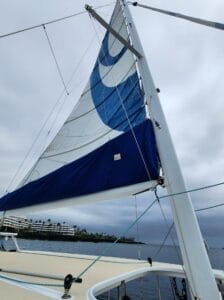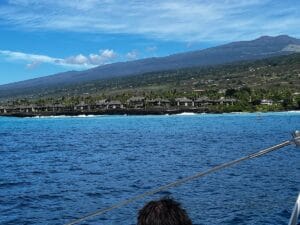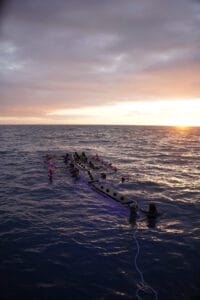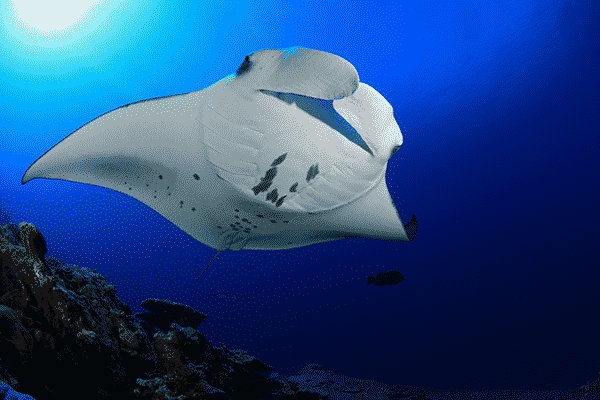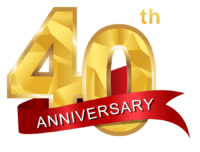Join us on the Hoku Nui to create a wonderful memory in the pristine waters off the Kona Coast. Our snorkel or manta ray tours are the best and not to be missed.
Discover Wildlife reports on interesting facts about humpback whales. Winter is the time to see them off the coast of Hawaii and especially the months of November, December and January.
Learn all about these giant sirens of the sea.
Where does the name humpback come from?
Humpback whales are named, predictably, after an obvious hump in front of their small dorsal fin. Compared to those of other whales and dolphins, this dorsal fin is small and stubby. This hump is emphasised when they raise and bend their backs in preparation for a dive.
How big are humpback whales?
Humpback whales grow to between 15 and 19 metres in length (about the size of a bus) and weigh approximately 40 tons. One of their most noticeable and distinctive features are their long and ungainly-looking pectoral fins (flippers). These can grow to nearly 5 metres long, making them relatively the longest flippers of any baleen whale.
This feature is related in their Latin name, Megaptera novaeangliae, which means “big wing of New England.” Although they may look overly long and cumbersome scientists have found that they are actually vey hydrodynamic and well adapted for manoeuvrability.
What do humpback whales eat?
Humpbacks are baleen whales, which means that they have a specialised filter feeding systems inside their mouths. They filter their food through baleen plates, which are made up of fringed brushes which grow in rows from the upper jaw.
They take huge gulps of water into their mouths, then push the water out through the plates, trapping their prey inside. This prey is mainly made up of krill – small crustaceans, as well as other small invertebrates, but may also include small schooling fishes such as anchovies, sardines, and mackerel.
Some humpback whales use an ingenious cooperative method to trap fish called ‘bubble netting’. These whales will dive below a school of fish then spiral back upwards blowing air bubbles as they go. As these bubbles rise they disorientate and trap the fish into a tight ball. The whales can then swim quickly upwards into the shoal and gulp down a concentrated mouthful of fish. This behaviour is often performed in groups, and is thought to be learned rather than instinctive, as some groups know how to do it and others don’t.
How long do humpback whales live?
As they don’t have teeth which could be used to estimate their age, it is hard to know how long they could live for. Some estimates say that they have a lifespan of approximately 50 years, whilst others say it could be up to 80.
Where can humpback whales be found?
Humpback whales can be found in every ocean in the world, but are most concentrated in a band running from the Antarctic ice edge to 81° N latitude. Where they can be commonly fund also depends on the temperature and the time of year. In the summer many spend their time in high-latitude feeding areas such as the Gulf of Alaska or the Gulf of Maine, then in the winter they can be found in the warmer waters near to the equator .
Are humpback whales at risk of extinction?
Intensive hunting over centuries by the whaling industry severely reduced humpback whale populations, such that the population of humpbacks in the western South Atlantic dropped to only about 450 individuals. It is estimated that at least 300 000 individuals were killed worldwide.
Protections were put in place in the 1960s, and a complete ban on commercial whaling was put in place in 1985 (although some countries still hunt whales under the guise of ‘scientific whaling’). Since the ban populations of humpbacks have steadily recovered. Encouragingly, a newly published study has reported a significant population rebound, with the current abundance in the western South Atlantic now close to 25,000 whales, an estimate beloved to be close to pre-whaling numbers.
Although as recently as 1988 humpbacks were listed as endangered, the IUCN now classifies them as ‘least concern’. They are however still under threat from hunting in west Greenland and on Bequia, St. Vincent and the Grenadines, from collisions with ships, and entanglement in fishing gear.
Do humpback whales live in social groups?
Humpback whales do not live in tight-knit social groups, instead they travel either alone or in transient groupings of two or three individuals (pods) that disband after a few hours, although longer-term associations have been observed.
They may gather together for longer to hunt and feed however, for example when bubble-netting cooperatively as described above, and males may band together into “competitive groups” around a female to try and mate with her.
How do humpback whales reproduce?
Humpback whales have fairly complex courtship rituals that take place during the winter months. Before these can begin however, the whales must first congregate in the warm equatorial breeding waters, often travelling thousands of miles from their summer feeding grounds to find a mate.
Once they arrive the males need to earn the right to mate with a female, and this involves often fierce competition. Unrelated males will group together to tail females and will fight each other around her, breaching, tail-slapping, and charging at one another. In doing so they hope to impress the female with their dominance and strength. Most of this fighting is for show however, and it is rare that they will cause each other serious physical harm.
Singing also plays a part in reproduction. It is thought that males will use song to attract the female, as well as to show dominance. It may also have an important role in inducing oestrus in females.
Once mating has occurred, the gestation period for female whales is 11.5 months. Once born, the calves are between 3 and 4.5 m long and weigh up to a ton.
Do humpback whales communicate?
Humpback whales are well known for their haunting, evocative calls or ‘songs’. These complex sequences of moans, howls, and cries can last for hours and travel vast distances through the ocean.
The exact function of humpback song’s is not known, but there are many theories.
As it is the male that produces the long complex songs (females have shorter vocalisations), and these are produced during the breeding season, it is speculated that they may function to attract females. It could also act as a challenge to other males. Yet another theory is that it has an ecolocative function, acting as a sonar, so that the whales can ‘see’ and navigate around their environment.
Humpbacks also use grunts, groans, and snorts to communicate with one another, and calfs are known to ‘whisper’ to their mothers, using low tones that can only be heard from short distance away. This may help them to avoid predators and big males.
Are humpback whales dangerous?
Humpback whales are by nature mostly gentle and non-aggressive animals, so it is very unlikely for them to do any harm to a human. They are however very large and curious and will sometimes approach boats.
Due to their acrobatic tendencies its is possible for them to breach and strike boats, and there was a case in 2015 of a Canadian woman who was killed when a breaching humpback whale landed on the snorkelling tour boat she was on. This is however extremely rare as humpbacks tend to be aware of their surroundings and avoid direct contact with boats and swimming humans.


